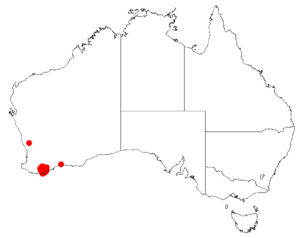Stirling Range coneflower facts for kids
Quick facts for kids Stirling Range coneflower |
|
|---|---|
 |
|
| Isopogon baxteri in the Stirling Range | |
| Scientific classification | |
| Genus: |
Isopogon
|
| Species: |
baxteri
|
 |
|
| Occurrence data from Australasian Virtual Herbarium | |
| Synonyms | |
|
Atylus baxteri (R.Br.) Kuntze |
|
The Stirling Range coneflower, also known as Isopogon baxteri, is a special plant. It belongs to the Proteaceae plant family. This coneflower only grows in one place: the southwest part of Western Australia. It is a straight-growing bush with unique leaves. These leaves are shaped like a wedge and often have three lobes, or sections. They also have small teeth along their edges. The plant produces round, flat flower heads. These flowers are pink and covered in soft hairs.
Contents
What the Stirling Range Coneflower Looks Like
The Stirling Range coneflower is a bush that stands upright. It usually grows between 0.2 and 1.5 meters tall. Its small branches are reddish to brown and have tiny hairs.
Leaves and Flowers
The leaves of this plant are shaped like a wedge. They are about 20 to 45 millimeters long. Many leaves have three distinct lobes. They also have twelve to fourteen sharp teeth along their edges.
The flowers grow in flat, round heads. These heads are about 30 to 35 millimeters wide. The flowers themselves are about 35 millimeters long. They are pink and covered with grayish hairs. At the base of the flower heads are special hairy, egg-shaped leaves called involucral bracts.
When it Flowers and What Fruit it Makes
The Stirling Range coneflower blooms from August to January. After flowering, it produces a type of fruit called a nut. These nuts are hairy. They grow together in a single, round or oval head. This fruit head can be up to 22 millimeters wide.
How the Stirling Range Coneflower Got its Name
The plant Isopogon baxteri was first officially described in 1830. A famous botanist named Robert Brown gave it its scientific name. He wrote about it in his book called Supplementum.
The plant was named after William Baxter. He was a botanist who collected plant samples in 1823. He found these samples near a place called King George's Sound.
Where the Stirling Range Coneflower Lives
This special coneflower grows in specific areas. It can be found in heathlands or shrublands. These areas are located in the Stirling Range. It also grows near Mount Barker. Both of these places are in the southwest part of Western Australia.
Conservation Status
The Government of Western Australia's Department of Parks and Wildlife has classified Isopogon baxteri as "not threatened." This means the plant is not currently in danger of disappearing.

